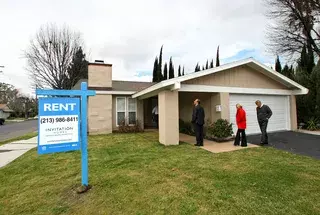Have you ever dreamed of investing in real estate but been deterred by the hefty price tags and extensive research involved? Well, now you can dip your toes into the real estate market with fractional investing. This new trend allows you to buy a share of a home, rather than the entire property. But is it really a viable option for the average investor? Let's take a closer look.
Changing the Real Estate Landscape
Fractional real estate investing is gaining momentum, thanks to platforms like Arrived Homes that allow investors to buy fractions of single-family homes. This innovative approach to real estate investment provides a stepping stone for aspiring landlords or those looking to dip their toes into the rental market. It offers insights into the costs and challenges of owning a rental property without the need for a substantial down payment.
Joshua Heier, a 30-year-old investor in California, is one of many investors who have embraced fractional real estate investing. He has invested a modest $2,900 through Arrived Homes and has seen his portfolio value grow to around $3,300. The appeal lies in the ease of getting started and the opportunity to generate passive income without the hassle of being a hands-on landlord.
Breaking Down Barriers
Fractional real estate investing platforms aim to remove barriers to entry in a market that has traditionally been difficult for individuals to access. Buying a home outright requires a significant upfront investment, time to qualify and close the deal, and ongoing expenses to manage the property. In contrast, fractional real estate allows investors to start with as little as $100 and takes care of property management and fees through rental income.
Arrived Homes CEO and co-founder Ryan Frazier highlights that more than 40 percent of their investors are renters themselves. The flexibility and freedom that fractional real estate offers are particularly appealing to a new generation of investors who value mobility and don't want to be tied down to homeownership.
The Rise of Fractional Real Estate Investing
Arrived Homes is not the only player in the fractional real estate market. Several other platforms, such as Fundrise, Lofty AI, Landa, Ark7, HappyNest, RealtyMogul, and DiversyFund, offer similar investment opportunities across different types of real estate. These platforms cater to a range of investors, allowing them to choose from commercial, residential, vacation, or mixed-use properties.
Nate Gipson, a 25-year-old program analyst from the Bay Area, started investing in fractional real estate in 2021. He was drawn to the accessibility of investing with platforms like Lofty AI, which allowed him to enter the market with as little as $5. Gipson sees fractional real estate as a way to save for a down payment on a single-family home without having to compete with skyrocketing prices.
The Caveats and Concerns
While fractional real estate investing opens doors to new opportunities, it does come with certain considerations. The convenience of having a platform handle property purchase, improvement, listing, and management comes at a cost. Fees associated with fractional real estate investing can vary across platforms and property types, which may impact your returns.
Critics argue that fractional real estate investing is not without risks. L.D. Salmanson, CEO of Cherre, a real estate data analytics company, questions the value proposition for retail investors. He suggests that investing in real estate investment trusts (REITs) may offer better diversification and returns for those seeking exposure to the real estate market.
The Socioeconomic Impact
The rise of fractional real estate investing highlights broader concerns about the housing market and its transformation by the tech sector. While it provides opportunities for individual investors, it also contributes to the financialization of housing. Investors, often backed by venture capital, are acquiring more properties, creating a shortage for first-time homebuyers, particularly those from marginalized communities.
Moreover, the influx of investors into the housing market can exacerbate issues related to housing stability, rising rents, and neglectful property management. Large investor-owned rental properties have been associated with higher eviction rates and decreased quality of life for tenants. Critics argue that such practices further widen the wealth gap and hinder access to affordable housing.
The Verdict
Fractional real estate investing offers an enticing entry point for aspiring investors, providing a taste of the real estate market without the traditional barriers. It democratizes an asset class that has historically been limited to those with significant capital. However, it is crucial for investors to carefully consider the fees, risks, and potential impact on housing affordability.
If you're an experienced investor or have a strong financial foundation, fractional real estate investing can be a viable addition to your portfolio. For novice investors with limited resources, it might be prudent to establish a solid base of traditional investments before venturing into this niche market. Remember, every investment carries some level of risk, and thorough research and financial planning are key to making informed decisions.
So, should you buy a fraction of a house? The answer depends on your financial goals, risk tolerance, and long-term investment strategy. Fractional real estate investing can be a stepping stone towards property ownership or a means to diversify your portfolio. Just be sure to approach it with caution and realistic expectations.

- Executives from Invitation Homes tour a Los Angeles-area home that the company purchased, renovated, and turned into a rental property. (Photo credit: Mel Melcon/Los Angeles Times via Getty Images)

- A "for sale" sign hangs outside of a home in Atlanta last month. The Atlanta market in particular has flooded with investors looking for properties to turn into rentals. (Photo credit: Dustin Chambers/Bloomberg via Getty Images)













